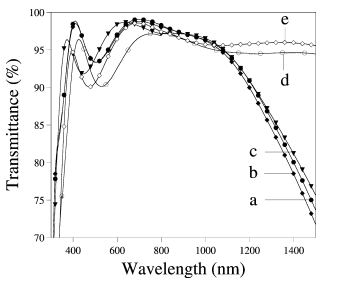We have investigated thin film of Indium Tin Oxide (ITO) deposited on glass substrates by thermal annealing and by H3PO4 chemical etching in order to improve their quality for use in polymer based light-emitting diodes. The morphology of the film surface was significantly changed by both treatments as observed by scanning electron microscopy (SEM) and atomic force microscopy (AFM). The sheet resistivity of the annealed sample was found to be dependent on the annealing temperature, while it was practically not affected by the chemical treatment. On the chemically treated samples, analysis of the film surface by X-ray photoelectron spectroscopy (XPS) revealed that a thin ionic phosphorus layer was formed on the ITO surface. The electrical and optical characteristics of light-emitting diodes with poly(2-methoxy,5- (20 -ethylhexyloxy)-1,4-phenylene vinylene) or MEH-PPV as an active layer, deposited on treated and untreated ITO substrates were determined and compared. Subsequent enhancement of performance of the diodes was obtained with treated ITO substrates, proving the efficiency of the performed treatments.
One of the factors that influence the performance of organic light-emitting diodes (OLEDs) is the charge injection rate from the electrodes into the emitter. Because the injection mechanism occurs through the contact formed between the electrode and the organic material, the nature of the interface has a strong impact on the efficiency of the device. It has been found that the properties of indium tin oxide (ITO) used as an anode in OLEDs can affect the performance of the devices by its morphology as well as its electronic properties [1,2]. It should be noted that the physical properties of ITO depend largely on the deposition techniques [3] and its stability can be affected by the cleaning process. In search in improving the stability of the ITO films, several investigations have been carried out to study modification of the surface upon subsequent treatment including thermal treatment [4], plasma treatment [5], aquaregia treatment [6], and acid treatment [7].
In this study, we have investigated the effects of thermal and acid treatment of ITO thin films obtained by electron beam deposition techniques. The surface properties were studied by X-ray photoelectron spectroscopy (XPS), atomic force microscopy (AFM), scanning electron spectroscopy (SEM), optical absorption and Raman spectroscopy. Devices using poly(2-methoxy,5-(20 -ethylhexyloxy)-1,4-phenylene vinylene) (MEH-PPV) as an active layer deposited on treated and untreated ITO were characterized and their performances were compared.
ITO thin films were prepared on glass substrates by electron beam deposition techniques. A commercial powder of ITO (supplied by Aldrich) was pressed into pellets, which were used as a crucible and evaporated by an 8.5 kW egun. The oxygen pressure in the chamber was set at 2 104 mbar during the evaporation and the temperature of the substrate was 200 8C. The thickness the ITO film was about 500 nm as measured by a Tencor Alphastep profiler. These samples are denoted as standard ITO samples.

Fig1
For wavelengths below 1000 nm, the transmittance of the thermally treated samples remains very similar to that of a standard ITO sample (Fig. 2), suggesting that the optical quality of the material in the visible was not altered by the treating processes used. In contrast, with high annealing temperatures (>350 8C) and near the infrared region, an improvement of the transmittance was obtained. The spectra of the acid etched films are identical to that of a standard ITO sample, indicating that no significant modification has occurred in these samples.
As previously mentioned, the quality of ITO films depends on the preparation methods. Several reports have mentioned substantial modifications of the optical properties of ITO after thermal treatments [12]. These modifications were related to an enhancement of the crystallinity of the oxide induced by heat treatment [13]. In these cases, a change in color was often observed in the ITO substrates, which became darker. The transmittance of the films will decrease, in contrast with the results obtained in this study. In fact, we observe an improvement of the transmittance in the infrared region, while in the visible range it remains practically identical to that obtained in a standard ITO film.